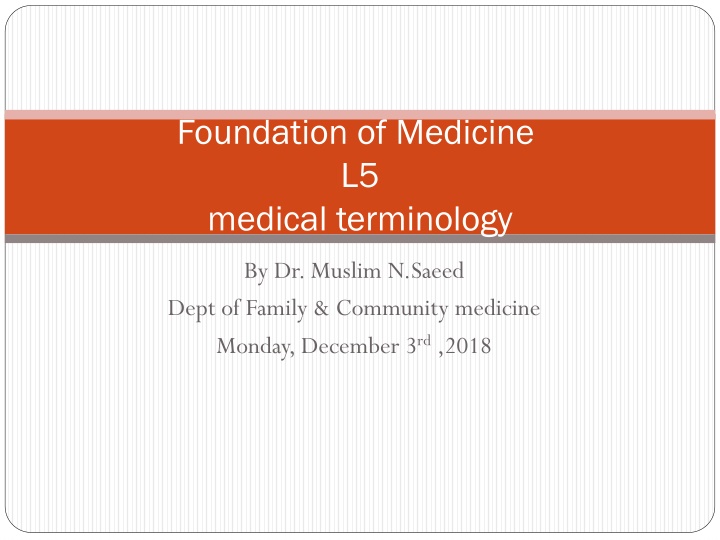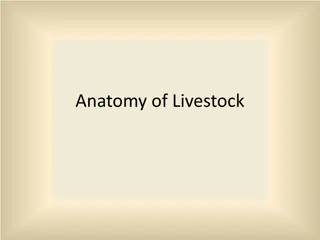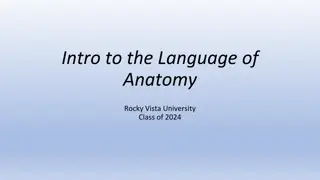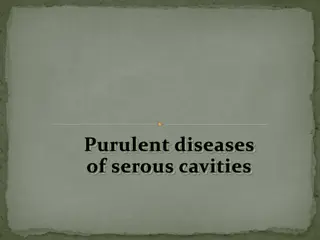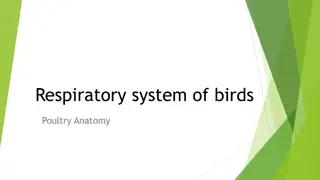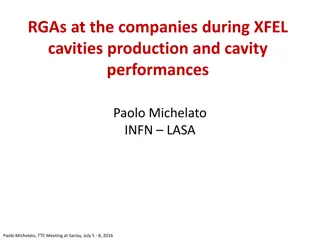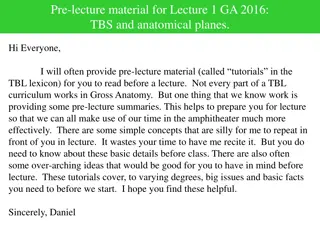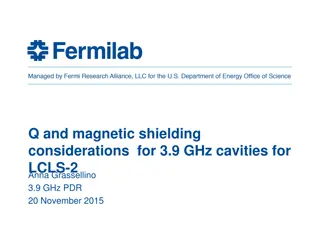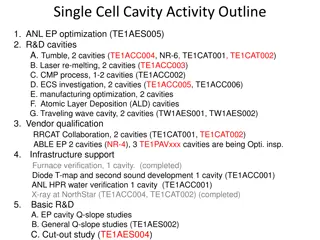Major Body Systems and Cavities in Human Anatomy
Understanding the major body systems, including skeletal, muscular, cardiovascular, lymphatic, immune, respiratory, digestive, urinary, nervous, endocrine, reproductive, integumentary, and special senses systems, as well as the dorsal cavity comprised of the cranial and spinal cavities. Each system plays a vital role in maintaining the overall health and function of the human body.
Download Presentation

Please find below an Image/Link to download the presentation.
The content on the website is provided AS IS for your information and personal use only. It may not be sold, licensed, or shared on other websites without obtaining consent from the author.If you encounter any issues during the download, it is possible that the publisher has removed the file from their server.
You are allowed to download the files provided on this website for personal or commercial use, subject to the condition that they are used lawfully. All files are the property of their respective owners.
The content on the website is provided AS IS for your information and personal use only. It may not be sold, licensed, or shared on other websites without obtaining consent from the author.
E N D
Presentation Transcript
Foundation of Medicine L5 medical terminology By Dr. Muslim N.Saeed Dept of Family & Community medicine Monday, December 3rd,2018
MAJOR BODY SYSTEMS MAJOR BODY SYSTEMS Body System Major Structures Major Functions bones, joints, and cartilage -Supports and shapes the body. -Protects the internal organs. -Forms some blood cells . -stores minerals. Skeletal System muscles, fascia, and tendons Holds the body erect. Makes movement possible. Moves body fluids and generates body heat. Muscular System heart, arteries, veins, capillaries, and blood Blood circulates throughout the body to transport oxygen and nutrients to cells, and to carry waste products to the kidneys where waste is removed by filtration. Cardiovascular System lymph, lymphatic vessels, and lymph nodes Removes and transports waste products from the fluid between the cells. Destroys harmful substances such as pathogens and cancer cells in the lymph nodes. Returns the filtered lymph to the bloodstream where it becomes plasma again. Lymphatic System tonsils, spleen, thymus, skin, and specialized blood cells Defends the body against invading pathogens and allergens. Immune System
MAJOR BODY SYSTEMS MAJOR BODY SYSTEMS Body System Major Structures Major Functions nose, pharynx, trachea, larynx, and lungs Brings oxygen into the body for transportation to the cells. Removes carbon dioxide and some water waste from the body.. Respiratory System Digestive System mouth, esophagus, stomach, small intestines, large intestines, liver, and pancreas Digests ingested food so it can be absorbed into the bloodstream. Eliminates solid waste. Urinary System kidneys, ureters, urinary bladder, and urethra Filters blood to remove waste. Maintains the electrolyte and fluid balance within the body. Nervous System nerves, brain, and spinal cord Coordinates the reception of stimuli. Transmits messages throughout the body. Endocrine System adrenal glands, gonads, pancreas, parathyroids, pineal, pituitary, thymus, and thyroid Integrates all body functions.
MAJOR BODY SYSTEMS MAJOR BODY SYSTEMS Body System Major Structures Major Functions Male: penis and testicles Female: ovaries, uterus, and vagina Produces new life. Reproductive Systems skin, sebaceous glands, and sweat glands Protects the body against invasion by bacteria. Aids in regulating the body temperature and water content. Integumentary System Special Senses eyes and ears Receive visual and auditory information and transmit it to the brain.
Major Body Cavities 1-The Dorsal Cavity The dorsal cavity, which is located along the back of the body and head. Divided into: A-The cranial cavity, which is located within the skull, surrounds and protects the brain. Cranial means pertaining to the skull. B-The spinal cavity, which is located within the spinal column, surrounds and protects the spinal cord.
2-The Ventral Cavity The ventral cavity , which is located along the front of the body , contains the body organs that maintain homeostasis. A-The thoracic cavity (thoh-RAS-ick), also known as the chest cavity or thorax, surrounds and protects the heart and the lungs. *The diaphragm is a muscle that separates the thoracic and abdominal cavities.
B-The abdominal cavity (ab-DOM-ih-nal) contains primarily the major organs of digestion. *This cavity is frequently referred to simply as the abdomen (AB-doh-men). C-The pelvic cavity (PEL-vick) contains primarily the organs of the reproductive and excretory systems.
Regions of the Thorax and Abdomen Regions of the Thorax and Abdomen 1.The hypochondriac regions (high-poh- KON-dree-ack): means below the ribs. (hypo- means below, chondr/i means cartilage, and -ac means pertaining to). Right and Left Hypochondriac regions. 2. The epigastric region (ep-ih-GAS- trick) is located above the stomach (epi- means above, gastr means stomach, and -ic means pertaining to). 3.The lumbar regions (LUM-bar): (lumb means lower back, and -ar means pertaining to).Right and Left Lumbar regions.
Regions of the Thorax and Abdomen Regions of the Thorax and Abdomen 4. The umbilical region (um-BILL- ih-kal) surrounds the umbilicus (um-BILL-ih-kus). 5.The iliac regions (ILL-ee-ack)(ili means hip bone, and -ac mean pertaining to).Right and Left Iliac. 6. The hypogastric region (high-poh- GAS-trick) is located below the stomach (hypo- means below, gastr means stomach, and -ic means pertaining to).
Quadrants of the Abdomen Quadrants of the Abdomen The term quadrant means divided into four 1.Right upper quadrant (RUQ) 2.Left upper quadrant (LUQ) 3.Right lower quadrant (RLQ) 4.Left lower quadrant (LLQ)
The Peritoneum The Peritoneum -The peritoneum (pehr-ih-toh-NEE-um) is a membrane that protects and holds the organs in place within the abdominal cavity. -Peritonitis (pehr-ih-toh-NIGH-tis) is inflammation of the peritoneum (periton means peritoneum, and -itis means inflammation).
Genetic Disorders hereditary disorder and congenital disorder Genetic disorder : -Down syndrome (DS) is a genetic variation that is associated with characteristic facial appearance, learning disabilities, and physical abnormalities such as heart valve disease. -Hemophilia (hee-moh-FILL-ee-ah) is a group of hereditary bleeding disorders. Congenital disorder: -A congenital disorder (kon-JEN-ih-tahl) is an abnormal condition that exists at the time of birth. Congenital means existing at birth.
TISSUES -A tissue is a group or layer of specialized cells that join together to perform certain specific functions. The four main types of tissue are epithelial, connective, muscle, and nerve. -Adipose tissue, also known as fat, provides protective padding, insulation, and support (adip means fat, and -ose means pertaining to) -Histology (hiss-TOL-oh-jee) is the study of the structure, composition, and function of tissues (hist means tissue, and -ology means a study of). -A histologist (hiss-TOL-oh-jist) is a specialist in the study of the organization of tissues at all levels (hist means tissue, and -ologist means specialist).
Incomplete Tissue Formation -Aplasia (ah-PLAY-zee-ah) is the defective development , or the congenital absence, of an organ or tissue (a- means without, and -plasia means formation). *Compare aplasia with hypoplasia. -Hypoplasia (high-poh-PLAY-zee-ah) is the incomplete development of an organ or tissue (hypo- means deficient, and -plasia means formation).
Abnormal Tissue Formation -Anaplasia (an-ah-PLAY-zee-ah) is a change in the structure of cells (ana- means excessive, and -plasia means formation). This abnormal cell development is characteristic of tumor formation in cancers. -Dysplasia (dis-PLAY-see-ah) is abnormal development or growth of cells, tissues, or organs (dys- means bad, and -plasia means formation). -Hyperplasia (high-per-PLAY-zee-ah) is the enlargement of an organ or tissue(hyper means excessive, and -plasia means formation). *Contrast hyperplasia with hypertrophy. -Hypertrophy (high-PER-troh-fee) is a general increase in the size, but not in the number, of cells in the tissues (hyper- means excessive, and trophy means development). This enlargement is not due to tumor formation. Contrast hypertrophy with anaplasia and hyperplasia.
GLANDS -A gland is a group of specialized epithelial cells that are capable of producing secretions. -Adenitis (ad-eh-NIGH-tis) is the inflammation of a gland (aden means gland, and -itis means inflammation). -Adenocarcinoma (ad-eh-noh-kar-sih-NOH-mah) is a malignant tumor that originates in glandular tissue (aden/o means gland, carcin means cancerous, and -oma means tumor). *Malignant means harmful, capable of spreading, and potentially life threatening. -Adenoma (ad-eh-NOH-mah) is a benign tumor that arises in glandular tissue (aden means gland, and oma means tumor). *Benign means not life threatening.
Pathology Pathology (pah-THOL-oh-jee) is the study of the nature and cause of disease that involves changes in structure and function. The word root (combining form) path/o and the suffix -pathy mean disease. A pathologist (pah-THOL-oh-jist) specializes in the laboratory analysis of tissue samples to confirm or establish a diagnosis (path means disease, and ologist means specialist). Postmortem means after death and a postmortem examination is also known as an autopsy (AW-top-see).
Premature birth : which is a birth that occurs earlier than 37 weeks of development, can cause serious health problems. The study of the medical problem and care of the aged is known as Geriatrics (jer-ee-AT-ricks).or as Gerontology (gerontologist). Both of these terms have the same meaning; however, geriatrics is the preferred term.
End End
